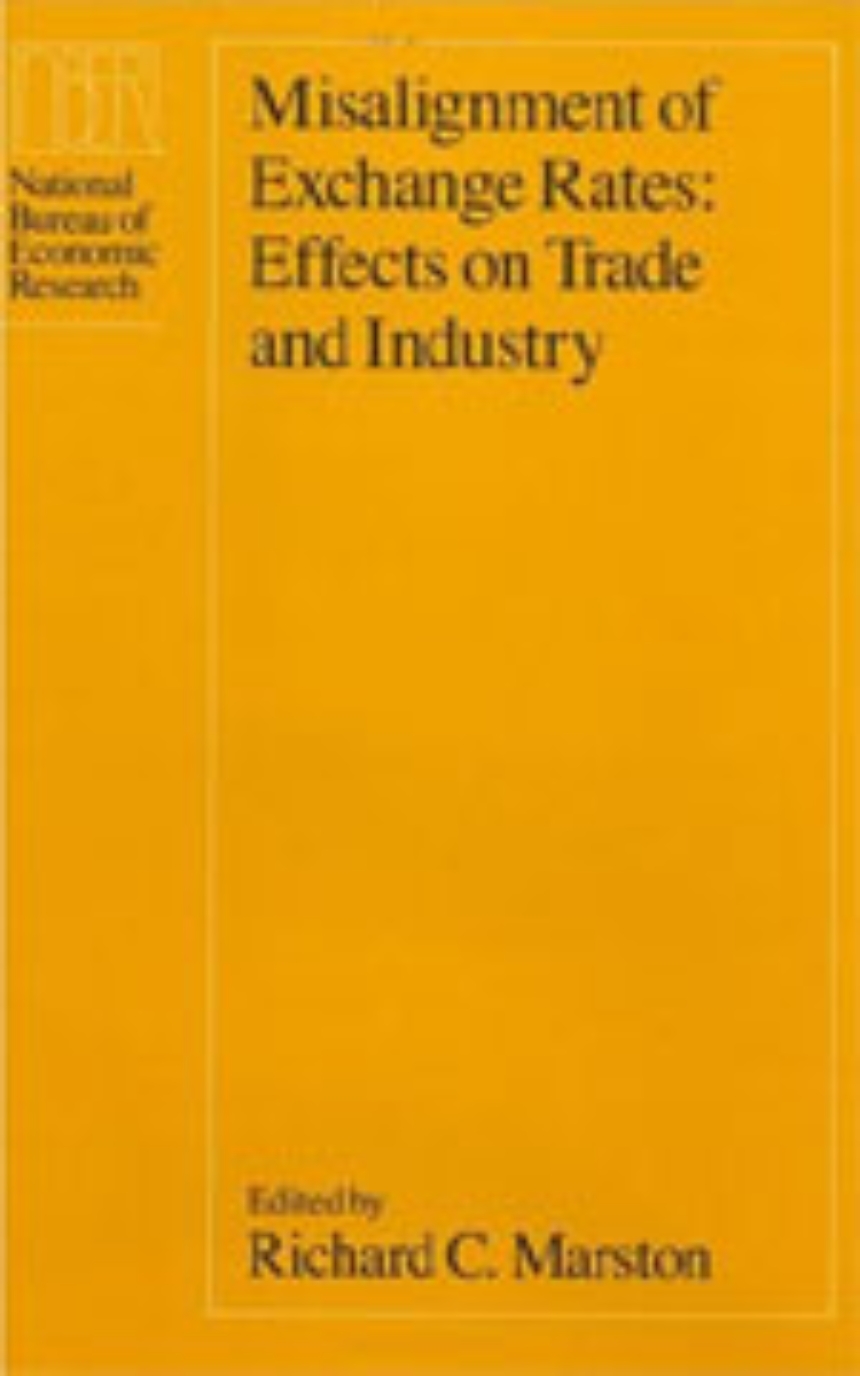Misalignment of Exchange Rates
Effects on Trade and Industry
Economists writing on flexible exchange rates in the 1960s foresaw neither the magnitude nor the persistence of the changes in real exchange rates that have occurred in the last fifteen years. Unexpectedly large movements in relative prices have lead to sharp changes in exports and imports, disrupting normal trading relations and causing shifts in employment and output. Many of the largest changes are not equilibrium adjustments to real disturbances but represent instead sustained departures from long-run equilibrium levels, with real exchange rates remaining "misaligned" for years at a time.
Contributors to Misalignment of Exchange Rates address a series of questions about misalignment. Several papers investigate the causes of misalignment and the extent to which observed movements in real exchange rates can be attributed to misalignment. These studies are conducted both empirically, through the experiences of the United States, Great Britain, Japan, and the countries of the European Monetary System, and theoretically, through models of imperfect competition. Attention is then turned to the effects of misalignment, especially on employment and production, and to detailed estimates of the effects of changes in exchange rates on several industries, including the U.S. auto industry. In response to the contention that there is significant "hysteresis" in the adjustment of employment and production to changes in exchange rates, contributors also attempt to determine whether the effects of misalignment can be reversed once exchange rates return to earlier levels. Finally, the issue of how to avoid—or at least control—misalignment through macroeconomic policy is confronted.
Contributors to Misalignment of Exchange Rates address a series of questions about misalignment. Several papers investigate the causes of misalignment and the extent to which observed movements in real exchange rates can be attributed to misalignment. These studies are conducted both empirically, through the experiences of the United States, Great Britain, Japan, and the countries of the European Monetary System, and theoretically, through models of imperfect competition. Attention is then turned to the effects of misalignment, especially on employment and production, and to detailed estimates of the effects of changes in exchange rates on several industries, including the U.S. auto industry. In response to the contention that there is significant "hysteresis" in the adjustment of employment and production to changes in exchange rates, contributors also attempt to determine whether the effects of misalignment can be reversed once exchange rates return to earlier levels. Finally, the issue of how to avoid—or at least control—misalignment through macroeconomic policy is confronted.
328 pages | 66 line drawings, 52 tables | 6.00 x 9.00 | © 1988
National Bureau of Economic Research Project Report
Economics and Business: Business--Industry and Labor, Economics--International and Comparative, Economics--Money and Banking
Table of Contents
Preface
Introduction
Richard C. Marston
1. Sources of Misalignment in the 1980s
William H. Branson
Comment: Maurice Obstfeld
2. Sterling Misalignment and British Trade Performance
Charles R. Bean
Comment: Willem H. Buiter
3. Exchange Rate Variability, Misalignment, and the European Monetary System
Paul De Grauwe and Guy Verfaille
Comment: Jacques Melitz
4. Realignment of the Yen-Dollar Exchange Rate: Aspects of the Adjustment Process in Japan
Bonnie Loopesko and Robert A. Johnson
Comment: Richard C. Marston
5. Roundtable on Exchange Rate Policy
Stanley W. Black, Dale W. Henderson, and John Williamson
6. Monopolistic Competition and Labor Market Adjustment in the Open Economy
Joshua Aizenman
Comment: Stephen J. Turnovsky
7. On the Effectiveness of Discrete Devaluation in Balance of Payments Adjustment
Louka T. Katseli
Comment: Alberto Giovannini
8. Exchange Rates and U.S. Auto Competitiveness
J. David Richardson
Comment: Robert Lawrence
9. U.S. Manufacturing and the Real Exchange Rate
William H. Branson and James P. Love
Comment: Robert M. Stern
10. Long-Run Effects of the Strong Dollar
Paul Krugman
Comment: Kala Krishna
11. New Directions for Research
Rudiger Dornbusch
List of Contributors
Name Index
Subject Index
Introduction
Richard C. Marston
1. Sources of Misalignment in the 1980s
William H. Branson
Comment: Maurice Obstfeld
2. Sterling Misalignment and British Trade Performance
Charles R. Bean
Comment: Willem H. Buiter
3. Exchange Rate Variability, Misalignment, and the European Monetary System
Paul De Grauwe and Guy Verfaille
Comment: Jacques Melitz
4. Realignment of the Yen-Dollar Exchange Rate: Aspects of the Adjustment Process in Japan
Bonnie Loopesko and Robert A. Johnson
Comment: Richard C. Marston
5. Roundtable on Exchange Rate Policy
Stanley W. Black, Dale W. Henderson, and John Williamson
6. Monopolistic Competition and Labor Market Adjustment in the Open Economy
Joshua Aizenman
Comment: Stephen J. Turnovsky
7. On the Effectiveness of Discrete Devaluation in Balance of Payments Adjustment
Louka T. Katseli
Comment: Alberto Giovannini
8. Exchange Rates and U.S. Auto Competitiveness
J. David Richardson
Comment: Robert Lawrence
9. U.S. Manufacturing and the Real Exchange Rate
William H. Branson and James P. Love
Comment: Robert M. Stern
10. Long-Run Effects of the Strong Dollar
Paul Krugman
Comment: Kala Krishna
11. New Directions for Research
Rudiger Dornbusch
List of Contributors
Name Index
Subject Index
